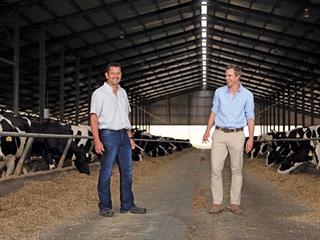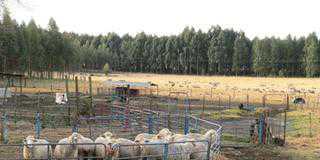
Automation in the dairy industry has flooded producers with data. To give this information more relevance, Chris Fourie and
Justin Moolman, owners of Dairy Management Consulting, recently initiated a benchmarking exercise among their 36 clients, across all total mixed ration (TMR) production systems.
The exercise, carried out in April last year in five provinces, concentrated on production systems, but also explored other indices such as production and capital costs. few similarities were found in the production practices of the top-performing dairymen. Differences included housing use, bedding, calf rearing and feeding regimes.
“The only common factor was that all were doing the basics right,” says Chris. ”This included providing a cool, clean living environment, giving colostrum as soon as possible after birth, and supplying sufficient fresh and clean water and food.” He says that dairymen should analyse production systems and identify areas that could be improved by getting the basics right before investing in equipment to boost production.
Size is not everything
Concentrate on the economics of the production system, rather than on herd size, stresses Chris. “The economically viable size of a dairy herd is currently about 450 cows in milk, depending on infrastructure. When considering increasing the herd size above this, a dairyman should work with a size he is comfortable with instead of chasing milk volume.”
He says producers with more cows than they can handle may be making basic errors, and may be better off with fewer cows and more time to attend to detail. “If the basics are in place but the operation needs to expand to remain economcally viable, a production manager should be appointed to assist the producer.”
The exercise revealed that the farms compared well with the international standard in terms of overall conception rate and first time conception rate. The cow group average was 32,2%, compared with the international average of about 30%. The top farm in this category achieved an average conception rate of 46,8% and a first artificial insemination (AI) conception rate of 45,5%.
On all top farms, the first AI conception rate in heifers at 15,2 months was equally impressive, at an average of 46,8% at
14,9 days for the group and 60,8% for the top herd. The findings suggested there will be a 1% to 2% increase in the number of first calf heifers produced for every month reduction of age in which a heifer produces her first calf.
Before insemination, the dairymen considered the age, weight and height over the withers of a heifer. The preferred age at first insemination varied from 12 months to 15 months, depending on the heifer’s weight and height. “The overwhelming
consensus among the top dairymen was that diligent post-calving management, in association with a vet, was crucial in achieving a high conception rate,” says Chris.
Cows calve separately in a cool clean space. Reducing heat and other stresses allows quicker recovery after calving, he explains. “In combination with a clean environment, this will make them less susceptible to bacterial infection that could increase the recovery period.” The team found nutritional management during the first three weeks before and after calving – the transition period – to be an important period of the cow’s lactation.
“This period is crucial for cow recovery, future reproduction and milk production,” says Justin. “This sets her up for the rest of her lactation. If she takes a knock during this period, it’s difficult to get her back to an optimal production level.” Farmers must provide successful nutrition, and Chris emphasises that a dairyman should use a nutritional consultant to ensure rations are
correct. Rations must be fresh and properly mixed, and feed bunks must be cleaned out regularly.
Cows need enough space to reduce competition for feed. A fresh cow needs feed bunk space of 75cm, while 60cm is
sufficient for a cow in mid- or late lactation. The voluntary waiting period was more or less the same amongst top dairymen, with firstlactation heifers having more time to recover. On average, this period for first-lactation heifers was 60 days in milk, and for second lactation cows and onwards, 50 days in milk.
Cows that did not conceive the first time were synchronised to prevent them from skipping the following time. Cows were dried up 60 days before calving.
Calf mortality
Most dairy farms use sex-sorted semen for AI. “Nobody wants bull calves anymore, so by using such semen a dairyman ensures only heifers,” says Chris. “This means that top dairymen no longer use natural mating. It is just too risky, as the bull can get injured or become sterile. AI also eliminates sexually transmitted diseases.” Advances in breeding software significantly reduce inbreeding in herds, the main cause for calf mortality and stillbirth.
“With the latest programmes, you simply enter the breeding objectives. The programme matches the cow with potential bulls that will attempt to achieve a goal with the specific parameters you set, such as eliminating inbreeding.”
Average stillborn and heifer mortality rates for the group were 8,3% and 8,8% respectively, in comparison with the international average of 10% for both. The top dairymen in these two categories averaged only 3% stillbirths and 2,3% mortality in heifers. The farm with the lowest stillbirth rate identified bull selection for calving ease and close supervision of steaming-up cows, especially at night, as crucial to success.
Most heifer mortality under 12 months occurred within 90 days after birth. The results showed that calves should receive
as much colostrum as possible, and the first 12 hours are critical. “Failure to do this is one of the main reasons why calves die within ten days of birth,” Chris says. The others usually die when they are about 60 days old, says Chris.
“Dairymen tend to think they need less attention at this stage.” Weaning is a stressful period, he says, so dairymen should not neglect calves at this time. The top five farms employed different calf rearing methods, which performed well in their
respective systems. All had dedicated rearing staff, and calves had access to clean water and a minimum of 19% protein daily. Protection from the elements was identified as important.
“Cow comfort protects them from disease, so they conserve energy for growth, development and maintaining homeostasis,” explains Chris. Four of the top five farms are situated near the sea at Hopefield or near Darling, both in the Western Cape, in areas far cooler than most other areas included in the exercise.
“This proves that cows must not be subjected to heat stress,” Chris says. "Under cool conditions, they suffer less stress and will lie down more often, which uses less energy. It means they can produce more milk/ kg fed, in comparison with cows that use energy to stand around in an attempt to cool down.”
Replacement
Factors such as longevity received less attention than did performance indices, with a direct impact on the bottom line, and Chris says that a cow with a high yield is more important than one that lives long but is a below-average producer. “Instead of longevity, we considered production/ day of life,” he explains. “The average cow is in milk for about a thousand days of her life. In the group, this averaged a cow producing about 16,5l of milk/day in her lifetime, with the top dairyman‘s herd achieving 21,6l per day.”
The lactation peak of the top-producing dairies averaged 47,87l for first lactation, 61,4l for second lactation and 65,58l for third lactation onwards. Most dairy farms were building their herds to accommodate rising production costs, and culling cows only when they became a burden, and not due to old age or failure to conceive.
“High-producing cows should be helped to conceive, rather than culled because they’re struggling to conceive,” Chris concludes.
Phone Chris Fourie on 082 920 4887, or email him at [email protected].












